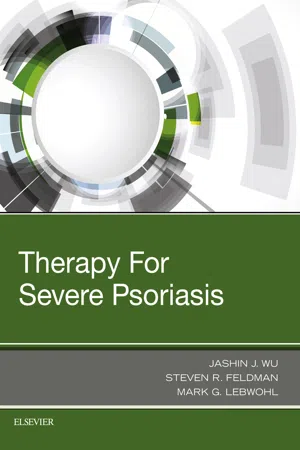
Therapy for Severe Psoriasis E-Book
Expert Consult
- 352 pages
- English
- ePUB (mobile friendly)
- Available on iOS & Android
Therapy for Severe Psoriasis E-Book
Expert Consult
About this book
A brand-new title in the field of dermatology, Therapy for Severe Psoriasis provides the ultimate coverage of the treatment options available for today's most serious cases, including biologics and oral therapies. It features discussions of the newest drug therapies, recent FDA-approved biosimilars, and combination approaches to care, while an overview chapter was designed to aid those new to the field in understanding the nuances of difficult-to-treat subtypes of psoriasis. Comprehensive and focused, Therapy for Severe Psoriasis will be a welcome addition to the library of any dermatologist seeking in-depth information on the challenges of this condition.- Each of the 16 chapters includes either an in-depth focus on a single therapy or an overview of a unique aspect of psoriasis, including: UVB therapy, methotrexate, acitretin, cyclosporine, apremilast, etanercept, infliximab, adalimumab, ustekinumab, secukinumab, and ixekizumab.- Takes an evidence-based approach to hard-to-treat severe psoriasis.- Discusses the newest drug therapies (such as ixekizumab), plus recent FDA-approved biosimilars, a topic unique to this particular psoriasis text.- Presents combination approaches for instances when standard treatments are not successful.- Includes an overview chapter to help beginners understand the nuances of the disorder.
Frequently asked questions
- Essential is ideal for learners and professionals who enjoy exploring a wide range of subjects. Access the Essential Library with 800,000+ trusted titles and best-sellers across business, personal growth, and the humanities. Includes unlimited reading time and Standard Read Aloud voice.
- Complete: Perfect for advanced learners and researchers needing full, unrestricted access. Unlock 1.4M+ books across hundreds of subjects, including academic and specialized titles. The Complete Plan also includes advanced features like Premium Read Aloud and Research Assistant.
Please note we cannot support devices running on iOS 13 and Android 7 or earlier. Learn more about using the app.
Information
Overview of Psoriasis
Keywords
Key points
Epidemiology
Age of onset
Cause and Pathogenesis
Development of a lesion
T cells
Table of contents
- Cover image
- Title page
- Table of Contents
- Copyright
- Dedication
- Contributors
- Foreword
- Preface
- Chapter 1. Overview of Psoriasis
- Chapter 2. Ultraviolet B Phototherapy
- Chapter 3. Psoralen-Ultraviolet Light A Therapy
- Chapter 4. Methotrexate
- Chapter 5. Acitretin
- Chapter 6. Cyclosporine
- Chapter 7. Apremilast
- Chapter 8. Etanercept
- Chapter 9. Infliximab
- Chapter 10. Adalimumab
- Chapter 11. Ustekinumab
- Chapter 12. Secukinumab
- Chapter 13. Ixekizumab
- Chapter 14. Biosimilars
- Chapter 15. Combination Therapies for Psoriasis
- Chapter 16. Investigational Therapies for Psoriasis
- Index